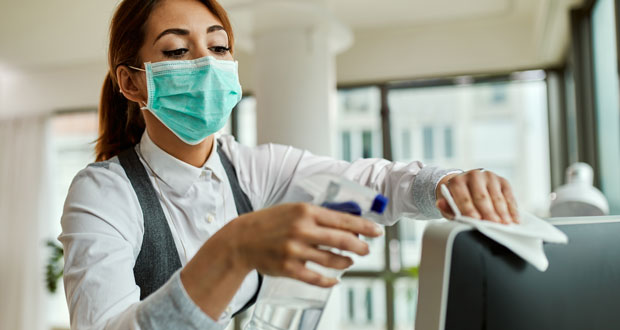FLU AND COLDS
According to Al Suter, UK FM Sales Executive for The Cheeky Panda Ltd: “Winter brings with it the annual onslaught of seasonal colds and flu, which, when added to a confined environment packed with people, is a classic recipe for a workplace cacophony of coughs, sneezes, and sniffles. The need to ensure a rigorous preventative approach to workplace out-breaks of colds and flu has never been more necessary, as Australia, the barometer for how badly seasonal colds and flu will occur in the UK, has had one of its worst seasons in decades.”
Suter advises that hard surfaces are key transmission sites, think door handles, keyboards, and desks; which can harbour cold, flu and similar viruses in an infectious state for several hours through to days. Using a cleaning fluid or disposable wipe which can destroy viruses (and where possible bacteria) will reduce the risk of transmission of seasonal viruses.
It is key to use a cleaning fluid or disposable wipe which has been tested against EN 1276 and EN 14476, this certification means they will ‘kill’ most viruses and bacteria to a 99.99 per cent level which will help to prevent outbreaks within the workplace.
Make sure disposable tissues and hand towels are available for all staff and visitors to use, while hard surfaces can harbour viruses for many hours if not days, soft surfaces such as tissues reduce the viruses’ infectious state to around 20 minutes.
Regular use of hand sanitiser plus frequent hand washing are key preventative measures for spreading the winter colds and flu germs. Regular restocking and distribution of disposable tissues plus weekly email reminders for hand washing and hand sanitisation during the peak season can help to raise awareness and encourage compliance amongst members of staff. Ensure that awareness posters are also visible in key areas such as lobbies, toilets, and break rooms.
HYBRID ISSUES
Gary Breach, Managing Director at national professional cleaning services provider NECS explains that organisations who have adopted the hybrid model may believe that their cleaning requirements aren’t what they were Pre-COVID-19.
“This is a misconception and with employees working on different days or different times, keeping premises thoroughly clean and safe is even more critical to help reduce sickness and boost the productivity and wellbeing of employees. However, in some instances, organisations may have an increased expectation of its cleaning and hygiene.”
This is why he says: “Regardless of if you have a single site or multi-site, it is key to have a tailored and effective cleaning strategy. Cleaning schedules should be designed to meet the specific needs of the business and align with any new working models.”
Dirty environments can negatively impact the morale of employees. Cluttered workspaces, dirty toilets and untidy common areas can lead to stress and lack of focus amongst employees.
High contact areas such as work surfaces, communal areas and shared equipment need to be sanitised and disinfected regularly as they can become breeding grounds for bacterial growth. Examples of these areas are:
- Work surfaces: Telephones, desks, keyboards, monitors and mouses.
- Communal areas: Door handles, stair railings, windows, light switches, chairs, and tables.
- Shared equipment: Printers, fridges, microwaves, cupboards, and water coolers.
- Toilets – Toilets, floors, sinks and basins.
TOUCH FREE
For extra precaution, says Nick Falco, Product and Technical Director at Mechline Developments: “We always recommend investing in touch-free hand washing solutions. Through this, a facility will further reduce the risk of spreading germs and bacteria, as well as minimising the risk of cross infection and food poisoning. Not only can facilities help improve all-round hygiene, electronic and knee-operated basins will save money as they can reduce water consumption by up to 85 per cent.”
Finally, advises Falco, on its own, the rigorous cleaning of hard surfaces isn’t enough. Harmful viruses, bacteria and other sources of infection will still gather, putting customers and staff alike at risk, so in addition to implementing enhanced handwashing procedures, improving air quality through air cleaning can play a major part in raising the bar for hygiene across all public and hospitality environments.





